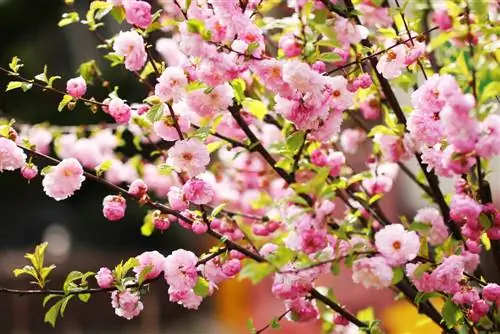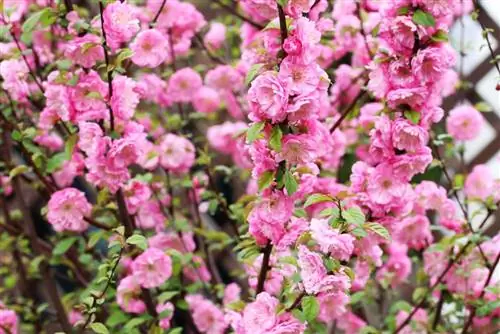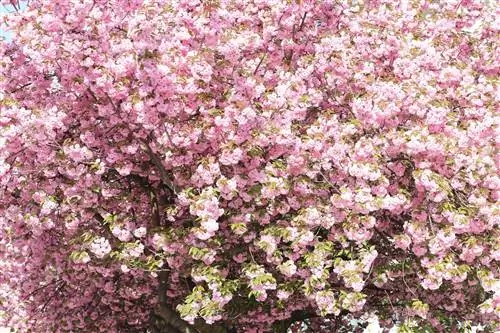- Author admin [email protected].
- Public 2023-12-17 03:39.
- Last modified 2025-01-24 12:45.
Every year spring dresses entire areas of the island of Mallorca in a delicate pink dress made of millions of small almond blossoms. People travel from far away to experience this magical moment up close. A tree that sparks so much enthusiasm must be something special. That's why it can certainly be found in gardens here too. Does the right cut spur him on to new flower records?
Is cutting a must?
If an almond tree is left alone by secateurs and pruning saws, it will still grow and thrive. Only then will it grow as nature shapes it. The wind and light, for example, determine the direction of growth of the branches. And since nature also loves unusual shapes, you may or may not like it very much. A desired growth habit, but also other reasons, suggest a cut. Early planning makes more sense than making subsequent corrections. When planting a young almond tree, considerations should be made in this regard and all the necessary information should be obtained.
What are the advantages of a cut?
Every cut has an impact on the growth of the almond tree, the development of the flowers and the harvest. If the cut is carried out professionally and at the appropriate time, the resulting changes will be consistently positive.
- the leaf dress is getting denser
- the crown gets a more beautiful shape
- Growth is stimulated
- Lifespan of the almond tree is extended
- Diseases are successfully combated
- An even more lush floral display follows
If the almond tree was not cut when it was young, later cuts may still make sense. If used correctly, they can still bring one or two advantages.
The right cutting tool
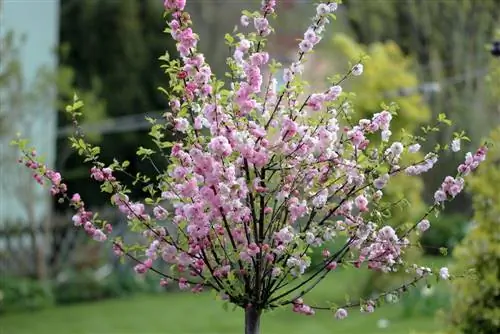
No matter how good the intentions are when cutting, if the cut is not carried out professionally, there is a risk of damage to the plant. In addition to the correct cutting technique, the right cutting tool is particularly important. Blunt blades lead to bruising of the shoots. Torn wound surfaces arise that only heal slowly. There is also an increased risk of fungal infection. Only use suitable and sharp tools.
- Roses scissors for thin shoots
- Pruning shears for thicker branches
- Tree saw for thick branches
The cutting tool must be cleaned very thoroughly before each use. It then needs to be disinfected to kill any pathogens that may be stuck to it. This is the only way to reliably prevent the spread of diseases. Gardening gloves also deserve special attention in this regard. Disinfect old gardening gloves before cutting or play it safe and use new, unused gloves.
Wound sealing
The topic of wound sealing comes up at the latest when a larger almond tree is cut. Until the individual interfaces heal, they are like open gates that offer access to all kinds of pathogens. The larger an interface, the longer this process takes and the longer it provides a target for disease. For this reason, cut surfaces with a diameter of 2 cm or more are sealed immediately after cutting. A wax is used for sealing, which is commercially available specifically for this purpose. Charcoal powder is also suitable for this. Get the sealing material in good time so that you can apply it straight away after cutting.
Possible cuts
The upbringing is usually applied annually from a young age and serves to shape the child. It depends on whether an almond tree or an almond bush is growing in the garden and which growth form the owner prefers. Rejuvenation pruning can breathe new life into old trees. It helps them to produce young shoots, more flowers and fruits. The clearing is done at regular intervals of a few years and ensures that the tree is freed from too many branches and so the whole almond tree gets more light again.
Whenever the branches are attacked by fungi or are weakened by pests, they must be cut away. As the final pruning option, radical pruning is a rescue method if the almond tree no longer wants to thrive. The best time for a cut depends on its type.
The upbringing cut
The training pruning is carried out after flowering. However, it is also possible to pick up the scissors a second time after the harvest in October. The aim of these pruning measures is to give the tree or shrub the desired shape and size. If the branches are cut evenly in height once or twice, the tree will grow in width. However, if side shoots are shortened, height growth is promoted. Width and height are limited by cutting all shoots back to the desired length. If you only want to maintain a certain growth habit, only the protruding branches need to be removed.

A standard tree is a popular shape for ornamental trees. If you want to achieve such a shape for your almond tree, you should start pruning accordingly early on. Proceed as follows for the young almond tree:
- Choose a trunk that is thick and well-grown.
- Cut away all other trunks and branches that are below the desired crown height.
- Short all upper shoots by a third in the first year.
- From the second year onwards, only cut the tips of the branches to achieve dense branching.
- Remove the tree from unwanted new shoots regularly from May to October.
Tip:
Attach a stick next to the trunk to tie it to. It gives it stability and also ensures upright growth. When the tree has become stronger, the stick can be removed again.
The Glade Cut
The clearing cut, also known as thinning cut, is carried out as needed. If the plant has grown too much and the branches are dense, they block each other's light. The result is that some branches no longer grow optimally and can hardly or not produce any leaves. Especially if the almond plant grows as a bush, thinning is necessary every two to three years. From May, directly after flowering, is the optimal time for such pruning measures. As with any cut, care must be taken to use sharp, clean and disinfected cutting tools when making a clearing cut. It doesn't matter whether the tree is he althy or not.
- Take away dried branches completely.
- Remove very thin shoots completely.
- Eliminate all wild shoots.
- Branches that grow inwards can also be removed.
- Cut branches that cross near the branches.
- Light out branches whose growth direction does not match the tree
- Two-year-old shoots have already bloomed and can be cut back to the old wood.
Tip:
Don't be too timid when cutting. It is better to cut a little more than too little. The almond tree tolerates the pruning measures well and will soon sprout vigorously.
The Rejuvenation Cut
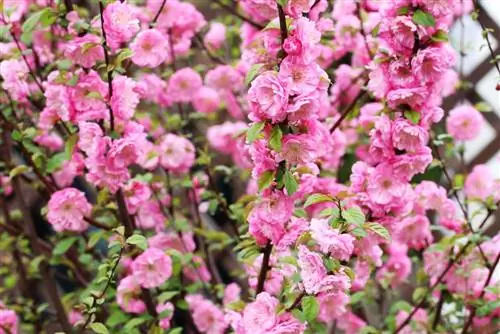
When an almond tree, botanically Prunus dulcis, gets old, its development often stalls. A rejuvenation cut can't give it any oomph. It receives fresh energy and sprouts again, like a young almond tree. More flowers and more fruit will be the result. The rejuvenation pruning is carried out early in the spring, before the almond tree has sprouted again. Make sure that the temperature required for trees is at least 5 degrees. A dry and sunny day should be chosen for this cut.
- Cut off the oldest shoots of the bush just above the ground. They can be easily recognized by their cracked bark. They are also darker than young shoots.
- New shoots should be shortened except for a few eyes.
- Lighten the tree generously.
The Radical Cut
If the almond tree no longer produces new shoots, flowers or fruits, this could be due to incorrect care or a lack of pruning. If the entire tree is in danger of dying, there is often only one last attempt at rescue: radical pruning. It must not be done on frosty days, even if frost is only expected in the following days. Otherwise the wood is too brittle for a clean cut. Frostbite can also occur on the larger cuts. The temperature should be at least above 5 degrees Celsius. A dry and sunny day is ideal. Moisture would slow down wound healing. Moisture combined with heat promotes the growth of fungi, which can easily penetrate open cuts.
- Short the main branches to two centimeters
- leave three to five leading branches
- cut diagonally
- seal large cuts with charcoal powder or wax
Tip:
It's best to wait until the Ice Saints in May before making the radical cut. After that, no more frost is expected until September.
Cutting when sick
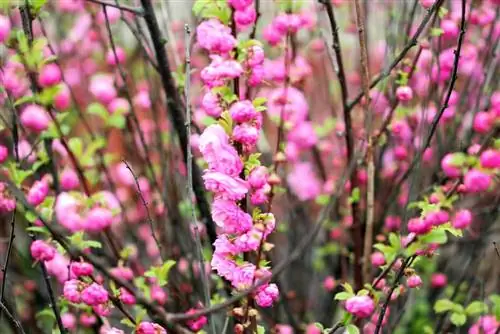
Almond trees often suffer from the fungal disease Molinia. It is also known as peak drought. This is the most common disease in almond trees and can be dangerous. The infestation usually occurs after the end of the flowering phase or in autumn. New shoots begin to wilt and become spindly. The transition points from diseased to he althy wood are covered by a rubbery mass. The tree defends itself against the disease with a rejection reaction. All infected shoots must be cut immediately, otherwise the infestation will spread to the entire plant in a few weeks.
It is absolutely important:
- act immediately
- remove all affected shoots
- cut into he althy wood, the cut surface should be green
- If there is a severe infestation, reduce almond trees by at least a third
- Disinfect cutting tools
- dispose of diseased plant parts safely in household waste
Note:
It is necessary that the almond tree is checked for fungal infestation the following year. If necessary, further cutting measures would have to follow.

